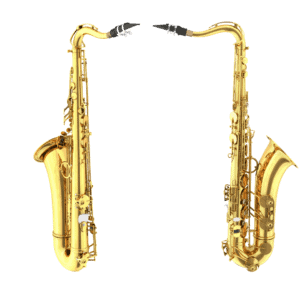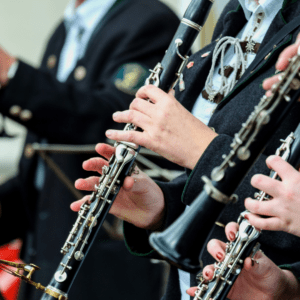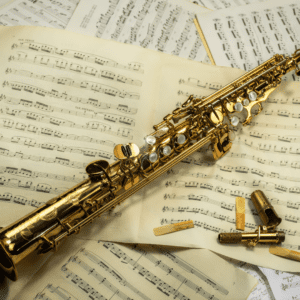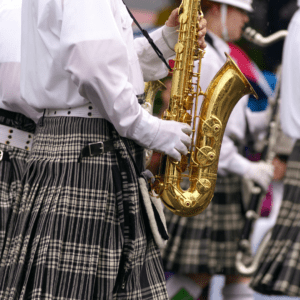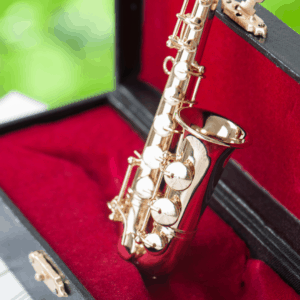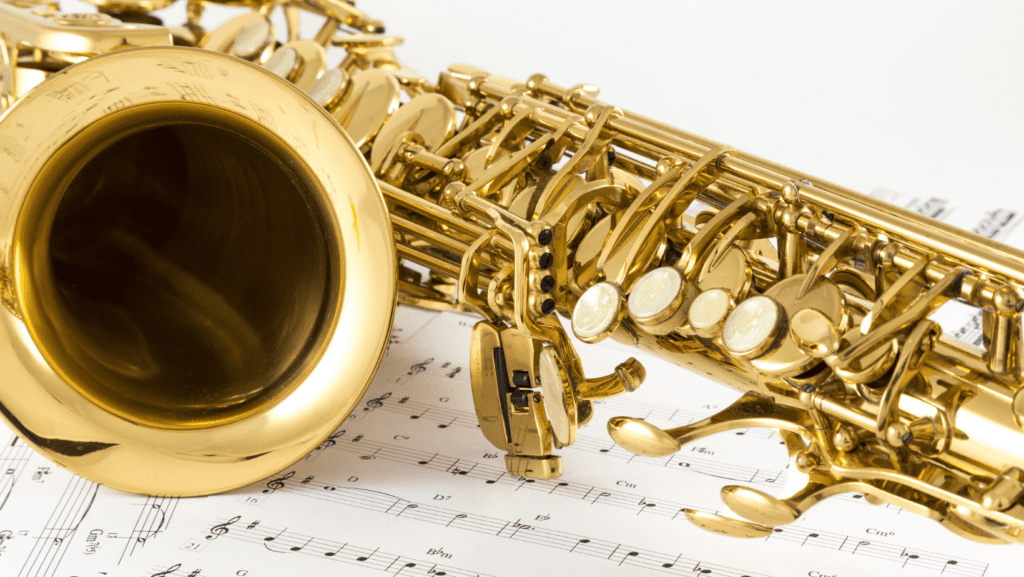
Are you thinking about learning how to play the saxophone? Are you wondering if you will be successful? Are you trying to learn more about the instrument before taking the next step? This article will help answer questions you might have before getting started!
Saxophone is easy to make your first sound on, but it takes time to develop and refine your sound. With dedicated practice, you can quickly start playing songs you recognize, but you will also never run out of new things to work on with the saxophone. Saxophone is a truly versatile instrument worth learning, and you can start playing at just about any age!
Do I need any prior experience before learning to play the saxophone?
There are three main groups of people starting to learn how to play the saxophone, all with various levels of prior background. The good news is that you do not need any prior musical knowledge when starting to learn the saxophone, but any knowledge you do have will still apply.
- People in group one have no musical training, do not play any instruments, and do not know how to read music.
- People in group two have a musical background and may already know how to read music, but are new to learning a musical instrument.
- Finally, people in group three already have a musical background, know how to read music, and have already played another instrument, but have not played the saxophone.
All three groups are capable of learning to play the saxophone, regardless of age or ability level, but the latter examples will obviously be able to learn at a faster pace. If you are a complete beginner to playing a musical instrument, you have more to learn at the beginning but can absolutely be successful!
The most important aspects to remember when getting started are to keep a positive attitude, remain patient, and enjoy the process; learning the saxophone is an ongoing journey!
How long will it take to learn the saxophone?
Over the first three to six months, you will see a drastic change in your development if you are practicing regularly. After playing for one to two years, you will be much more comfortable with the saxophone and how to play a variety of songs. At three to five years, you will start getting into more advanced repertoire and be able to play much more music.
Learning to play the saxophone is like learning a new language, so the more you use it, the better you will become at it. As mentioned earlier, the timeline can change depending on your prior experience. There is always something new to learn and the process never really stops!
There are excellent resources to help teach yourself what you want to learn, but having a private teacher as well will speed up the process, and ensure you start off correctly. Most private teachers get their students learning songs within the first few lessons, though the songs are shorter and simpler at first to help keep goals manageable.
You can study with a private teacher in person or online; both are great options. If you decide to meet with a private teacher online, it may be helpful to purchase an external microphone to improve audio quality during lessons. The Samson Go Mic is an affordable USB microphone that easily connects to your computer and improves audio quality. Using your computer microphone works, but using an additional microphone will help your teacher hear you better and offer you more specific feedback.
How do you make a sound on saxophone?
The sound you produce on saxophone is called the tone. The characteristic tone of the saxophone comes from a reed (almost always made of wood), vibrating when you blow air into the instrument.
Saxophones are typically made of metal, so they combine common elements of both woodwind and brass instruments, giving them a unique sound. Saxophones are still considered woodwind instruments though because they use a single reed, unlike brass instruments which require you to buzz into a cupped mouthpiece.
Some people have an easier time playing brass instruments such as trumpet or trombone if they are more comfortable buzzing into a cupped mouthpiece to make a sound. Others, however, may struggle with the concept of buzzing and will have an easier time playing the saxophone. Facial structure, oral cavity, and many other aspects can affect which comes more naturally to you.
The parts of the saxophone include:
- Mouthpiece
- Reed
- Ligature
- Neck
- Body
The mouthpiece is the small, narrow part where the reed is attached. You hold the reed to the mouthpiece with a ligature, which is tightened with screws. You put the mouthpiece on the neck, the skinnier curved part with cork at the top helping hold on the mouthpiece. The neck goes on the body of the saxophone, which is the main part of the instrument. A neck strap is used to help hold the instrument up while you play.
How do you play different notes on the saxophone?
You change what note you are playing on the saxophone by pressing down different finger combinations of keys.
Saxophone fingerings are similar to recorder fingerings, but the keys you press physically move up and down to cover holes on the instrument, rather than simply covering holes with your fingers. Woodwind instruments such as flute and oboe operate in a similar way
Flute and oboe fingerings are typically regarded as being more complicated than saxophone. Oboe is also a double reed instrument which is more difficult to play and harder to control the tone.
Clarinet also uses similar fingering combinations, however many of the fingerings do require you to cover holes with your fingers rather than always using keys. Sometimes, people switch between clarinet and saxophone because so many aspects are similar; they are both single reed woodwind instruments that use similar fingerings. If you have experience playing clarinet, you will likely have the easiest transition to learning the saxophone.
Which is easier to learn; saxophone or clarinet?
Many people think saxophone is easier to learn than clarinet because clarient has a wider range of fingerings; one could argue that saxophone is more difficult as there is a wider range of styles you can play. Playing the saxophone requires more flexibility where the clarinet is more consistent.
With the saxophone, you can add an octave key and many notes are played the same way; for example a low G and a high G are the same except for adding the octave key. Clarinet also has a register key similar to the saxophone octave key but the lower fingerings on clarinet are different from the higher fingerings. If you play a low C on clarinet then add the register key, the note becomes a high G. This can be more of a challenge adjusting.
Which is easier to learn; saxophone or trumpet?
Deciding on which is easier to learn between saxophone or trumpet is more ambiguous and up to the individual to decide on what comes more naturally.
Try buzzing your lips and make them vibrate against each other while keeping your teeth apart. Now blow air through a straw, but put your bottom lip over your bottom teeth and do not let any air leak out of the corners of your mouth. If you have an easier time buzzing your lips, trumpet will be easier to learn. If you have an easier time with the straw, the saxophone will be easier to learn. Both have different obstacles, but the general tone production comes more naturally to people.
What are the different types of saxophones?
There are several different types of saxophones, most commonly including alto, tenor, baritone, and soprano saxophone. While each type is generally played the same way, they are different sizes and play in different ranges.
Alto saxophone is the most common type of saxophone, and the one most people start learning as a beginner. The alto saxophone most often plays in a middle register without going extremely high or extremely low, though it can extend into a very wide range as you get more advanced.
Alto saxophone appears in classical music, popular music, jazz music, and many other genres. On one side of the spectrum, you can listen to Claude Debussy’s Rhapsody for Alto Saxophone and Orchestra. On the other end of the spectrum, you can listen to Thrift Shop by Macklemore and Ryan Lewis for a more recent example of the alto saxophone used in popular music. The alto saxophone fits into so many different settings.
Tenor saxophone is the second most common type of saxophone to start playing if you are a beginner. Many people who play tenor saxophone started on alto, then switched later on. Tenor saxophone is slightly bigger than the alto saxophone, and therefore sounds lower in pitch. The larger size may be difficult to manage for younger, smaller players. Tenor saxophone generally matches the pitch range of a trombone, a member of the low brass section; just like the alto saxophone, it can extend much higher as you become more advanced.
Tenor saxophone also appears in many settings. Many people recognize the sound of tenor saxophone from popular music and Saturday Night Live, where you can hear instances of playing in what is called the altissimo range (Italian for very high) on saxophone. Listen to the Saturday Night Live Closing Theme, “Waltz in A” to hear Lenny Pickett play tenor saxophone and incorporate the altissimo register. You can hear a classical tenor saxophone sound in Yasuto Tanaka’s rendition of The Swan by Camille Saint-Saëns.
Baritone saxophone is a larger saxophone producing a low tone. Most of the time, people do not start on baritone saxophone but switch to it later. While baritone saxophone does play in the same range as bass clef instruments, the sheet music is transposed to treble clef making it easier to switch from one saxophone to the other.
Baritone saxophone received more media attention over the past several years from Leo P and Too Many Zooz. You can also listen to Yasuto Tanaka playing Czardas on Baritone Sax for classical music on the baritone saxophone.
Soprano saxophone plays in a higher range than the alto. Soprano saxophone is sometimes mistaken for a clarinet as most soprano saxophones are straight without a curved neck. Some manufacturers do make curved soprano saxophones, but they are not as common. Once again, most people do not start with soprano saxophone but start playing it after learning to play on alto or tenor saxophone.
Soprano saxophone is more difficult to control the sound and requires the player to have a more developed playing ability. Many people recognize the soprano saxophone from Kenny G, and while not everyone likes his music, he does reach a wide audience helping more people hear the sound of the instrument. Here is Sidney Bechet and the Soprano Saxophone from Jazz at Lincoln Center’s Jazz Academy.
Other more unusual saxophones exist such as the sopranino, bass, contrabass, and subcontrabass saxophones. These are truly unique instruments but not as common, applicable, or recommended for beginners.
What are some beginning saxophones?
If you need to purchase an instrument, it is best to buy a high-quality, reputable brand such as Jupiter, Prelude by Conn-Selmer, Selmer, or Yamaha.
For a new instrument, you will likely need to spend $1,000 or more for a trustworthy instrument of high quality. Luckily, many websites like Amazon offer excellent financing deals where you can pay in installments, helping make the purchase more manageable.
Here are a few recommended beginning saxophones on Amazon to help narrow your options when selecting a saxophone:
- Jupiter JAS700 Student Eb Alto Saxophone
- Selmer Alto Saxophones
- Yamaha YAS-280 Alto Saxophone
- Prelude by Conn-Selmer AS711 Student Model Alto Saxophone Standard
One of the best beginning saxophones you can start with is the Prelude by Conn-Selmer AS711 Student Model Alto Saxophone Standard. The AS711 offers a great balance between value and quality. As mentioned above, Amazon offers a payment plan option where you finance the instrument over time, or you can trade it in for a more expensive model. Doing so offers you security in trying the saxophone before fully committing to a large purchase.
Many companies make saxophones at a lower cost, which may seem like a great deal, but you will likely spend more in repair costs as parts are cheaper and will not be as durable. The lower cost instruments also typically do not play as well, making the learning process much more frustrating in the early stages and you may get discouraged.
It is better to purchase a used instrument of one of the above brands, or another older manufacturer such as King or Martin; just factor in some additional funds to have the instrument fully serviced if you go that route to verify the saxophone is in good working condition.
What different styles of music can I play on the saxophone?
You can play many different types of music and styles with the saxophone. The most common differentiation regarding setup comes to the mouthpiece and reed combination you use; these combinations are commonly considered “classical” or “jazz” but they can be used in different settings.
Classical saxophone falls under traditional concert band, symphonic band, and wind ensemble playing that are offered in typical public school music education programs. While saxophone is not normally a member of an orchestra, there are some pieces that call for the instrument to be featured or join the traditional ensemble. Listen to Paul Creston’s Concerto for Alto Saxophone, Op. 26 featuring Rob Burton playing with a full orchestra.
Classical saxophone mouthpieces are usually more closed off inside, but are longer and more narrow. Classical reeds are generally thicker. This produces a warmer, darker, more balanced tone. This also allows players to blend into a larger ensemble easier without cutting through and sticking out.
Examples of popular classical saxophone mouthpieces include the Selmer C* and the Vandoren TL-3. One of the most popular classical reeds is the Vanodren Blue Box. Beginners should start at a 2 or 2.5 strength reed, but not any lower. Higher numbers are more difficult and should be used after you are more comfortable playing.
Jazz saxophone mouthpieces are obviously what is used when playing jazz; they are also normally the better choice for pop, rock, rap, hip-hop, funk, blues, R&B, and other contemporary genres. Jazz mouthpieces are usually shorter and have larger openings, giving them a more bright, edgy quality. This helps project volume and cut through the rest of the music better, making it a great choice for solo work within the listed genres.
Popular jazz mouthpieces include the Vandoren V16, Selmer Spirit 184, Meyer 5, and Dukoff 8. Using a jazz mouthpiece in a classical setting is normally not appropriate and is usually marked in the music if needed. Vandoren makes popular jazz reeds in a variety of options (i.e. Green Box, Red Box, V16, and ZZ). Usually, players will select lighter reeds with jazz mouthpieces to compensate for the extra open space, making it easier to control the sound.
When you get a saxophone, it should come with a mouthpiece (normally a classical style) and possibly a reed, but you will need to buy a new box of reeds and rotate through them as you practice. You should wait to upgrade to a jazz mouthpiece or more expensive classical mouthpiece once you are comfortable with fundamentals.
Summary
Saxophone is an excellent instrument with many possibilities. Whether you are brand new to music or have already started a musical journey and are interested in something new, saxophone has a lot to offer. You will be able to learn to play relatively quickly if you are motivated, especially if you have guidance from a teacher, and there is an extremely high ceiling for growth. Thank you for taking the time to read this article, and good luck going forward!


